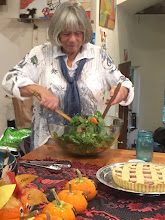When I made a seven-day trip to Costa Rica one summer, I had a wonderful time and saw some beautiful places, but I was not enthralled by Costa Rican cuisine, which seemed but an imported version of what we know as Mexican cuisine. Every dinner came with a mound of shredded iceberg lettuce topped with one or two slices of pale tomato, a large helping of rice, and a smaller proportion of black beans. Fried fish or chicken might complete the meal. Vegetables were seldom served, and those sold by street vendors lacked vibrancy and robustness.
Fruits, however, were abundant and good. I had a breakfast fruit plate with deep-red, juicy pieces of papaya; bland but still good watermelon; a banana that tasted like any banana I've eaten anywhere; and white pineapple so juicy, sweet, acidic, and flavorful it could have been the Prototype Pineapple. I got a good sample of Costa Rican oranges at a private home one morning when a thirteen-year-old boy picked two or three grapefruit-sized oranges from a backyard tree. With one unhesitating whack of a monstrous kitchen knife, his mother sliced off the top cap of one. With similar whacks, like chopping a stick into kindling, she tore off silver-dollar-sized pieces of rind, leaving a thick white skin around the orange. Then she showed me how to eat the orange out of its own thin-skinned bowl by scooping the flesh with my teeth. With a sharp bite and a deeply satisfying taste, that fresh-off-the-tree orange was one of the best things I ate in Costa Rica.
But it's not fair for me to judge Costa Rican food, since I have [had at that time] an allergy to peppers. [See "Confessions of a Picky Eater" and "The End of the Story about Peppers," May 11 and 18, 2020.] Peppers are the cuisine. The omnipresent rice is always cooked with flakes of red pepper. Eggs are scrambled with peppers. Peppers flavor meat, chicken, and fish. The first Spanish words I learned were "allergy" and "peppers." Ordering a meal at a restaurant, I would think I had made myself clear—no peppers, please—only to find questionable substances in my food, after all. "Aren't these peppers?" I would say, indicating the green spots in my scrambled eggs.
"Oh, but those are sweet peppers," the waitress would answer, as though the Spanish word for peppers meant only hot peppers. So I learned to say, "I have an allergy to sweet peppers, hot peppers, chili peppers—all peppers." Then I would make unmistakable getting-sick gyrations. The waitress would grin with understanding and leave, but when my dinner arrived, I would point to the rice and say, "What are those red specks?" and she would say, "Oh, no! They're peppers!" and snatch the plate to return to the kitchen. Peppers are so much a part of Costa Rican food people forget they're there.
I didn't get sick from peppers until my fifth day in Costa Rica, so my avoidance regime worked pretty well, though it greatly curtailed my culinary experience—as it might in many countries. When my son went to Thailand, he wrote me a postcard raving about Thai food but adding, "You would starve to death in Thailand. They put peppers in everything."
I didn't quite starve in Costa Rica. The fruits were delicious.
Next week: "Buddha, St. Francis, and Oliver at the Loma Vista Cafe"

No comments:
Post a Comment